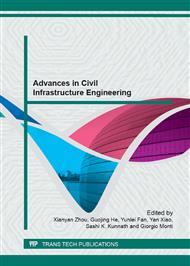p.859
p.866
p.870
p.875
p.882
p.886
p.891
p.896
p.901
An Optimal Distribution Strategy for Energy Dissipation Damper
Abstract:
A certain amount of viscous dampers are installed in the 10-storey frame structure in line with different distribution strategies, and then 2 sets of strong earthquake records and 1 set of artificial acceleration time-history curve are selected to conduct the time-history analysis under both frequently and rarely earthquakes via ETABS software. Based on the comparison of the time-history analysis results in various working cases, the ideal energy dissipation results can be obtained when the dampers are installed in the lower stories with a larger storey drift, which also help to utilize the upper space of the structure. The time-history analysis shows that the viscous dampers installed in the lower part of a building have a better effectiveness of vibration isolation than those in the upper parts, and it is no necessary to install too many dampers, for the energy dissipation effects tend to be steady when the number of dampers has been increased to a level.
Info:
Periodical:
Pages:
882-885
Citation:
Online since:
January 2013
Authors:
Price:
Сopyright:
© 2013 Trans Tech Publications Ltd. All Rights Reserved
Share:
Citation:


